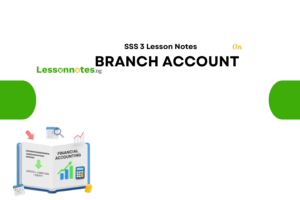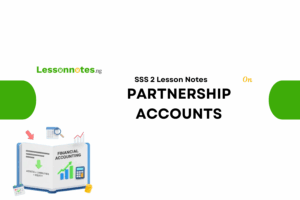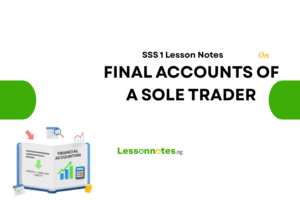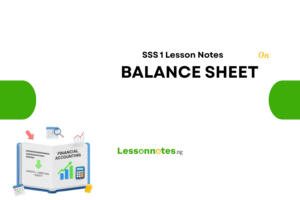Joint Venture Account SS3 Financial Accounting Lesson Note
Download Lesson NoteTopic: Joint Venture Account
CONTENT
- Definition of Joint Venture.
- Accounting entries are required for joint ventures.
- Practical illustration of joint ventures.
Definition
A joint venture is a business relationship of two or more persons or venturers, to carry on a particular transaction with the aim of profit-making. The principle of a Joint Venture borrows from a partnership but the difference is that the Venture ceases operation immediately after the purpose of its establishment is achieved.
Joint Venture is not a going concern.
Major accounts prepared are:
- Individual Joint Ventures Account: basically, the individual in joint ventures prepares joint venture accounts affecting him in his books.
- Memorandum Joint Venture Account: This is a profit and loss account of joint ventures. In this account, profit or loss attributed to each joint venture is ascertained and shared between the individuals concerned.
Accounting entries
- Debits all expenses to an individual Joint Venture account.
- Credited all revenue to Individual Joint Venture accounts.
- In Memorandum Joint Venture account.
- Credit both revenue of Joint Venture.
- Debits both expenses of Joint Ventures.
EVALUATION QUESTIONS:
- State three similarities between Joint Venture and Partnership.
- List four differences between Joint Venture and Partnership.
Practical Illustration: Biodun (Kaduna-based) and (Kola Lagos-based) agreed to enter into a Joint Venture in 1992, for the purchase of textile materials in Onitsha and resell.
Biodun and Kola agreed to share the profit or loss in a ratio of 3:2 respectively. The following transactions took place.
1992 Feb. 1 Biodun made a cash purchase of goods N2,200
4 Kola bought N3,500 worth of goods
10 Biodun purchased goods for N4,000
15 Biodun sold goods for cash N5000 selling expenses N430
20 Kola sold goods for cash, N6,500
25 The remaining items were dispatched to Kaduna by Kola, with transport expenses of N600
27 Biodun sold goods for N10,200
Prepare: (a) Individual Joint Venture account
(b) Memorandum Joint Ventures account
Note: In an individual Joint Ventures account, if the balance b/d is on the credit side, it implies that the person or firm has received more than he is entitled to. So he needs to pay the amount of the balance to the other party who has received less than his entitlement.
(a) In the books of Biodun:
Solution Joint Ventures with Kola
1992 N 1992 N
Feb. 1 Purchases 2,200 Feb. 15 Sales 5,000
“ 4 Purchases 4,000 Sales 10,200
“ 15 Selling expenses 430
“ 29 Share of profit 6,582
“ Bal. c/d 1988
15,200 15,200
Mar. 3 Cheque to Kola 1,988 M. I Balance b/d 1,988
In the Books of Kola:
Joint Venture with Biodun
1992 N 1992 N
Feb. 4 Purchases 3,500 Feb. 29 Sales 6,500
25 Transports Exp. 600 29 Balance c/d 1,988
29 Share of Profit 4,388
8,488 8,488
Mar. 1 Balance 1,988 Mar. 3 Cheque from Biodun 1,988
(b) In the books of Kola and Biodun:
Memorandum Joint Ventures Accounts
1992 1992
Purchases: Biodun 6,200 Sales Biodun 15,200
Kola 3,500 Kola 6,500
Selling exp. Biodun 430
Transport exp. Kola 600
Share of profit 10,730
Biodun (3/5 x 10, 790) 6,582
Kola (2/5 x 10,970) 4,388
21,700 21,700
Evaluation Question
- Define Joint Venture.
- Mention the major accounts prepared in the Joint Venture.
Reading Assignment:
- Essential Financial Accounting page 343-348
WEEKEND ASSIGNMENT
- The major accounts in Joint Venture are ____________ (a) Individual Joint Ventures account and memorandum (b) Profit and Loss account and balance sheet (c) appropriation account and balance sheet (d) cash book and ledger.
- Expenditure of each joint venture is ____________ (a) credited (b) debited (c) all of the above (d) none of the above
- Revenue of each joint venture is ______ (a) credited (b) debited (c) none of the above (d) all of the above
- In the memorandum account, revenue is _______ (a) Debited (b) Credited (c) averted (d) included
- In the memorandum account expenditure is ______________ (a) included (b) excluded (c) debited (d) credited
THEORY
A & B entered into a Joint Venture in a consignment of 100 articles each costing N10.
A supplies such goods and sends them to B for sale, paying carriage there on N20. B is to have a 10% commission on sales and the profit divided in the ratio of 2:1
It was found that 10 articles were below standard, and it was agreed that. A would take them back and sell them as his goods without commission and loss thereon being borne solely by A. It was further agreed that at the same time, 5 articles be returned to A as he was in a position to effect a sale (on account of the Joint Venture) at N18 each, being a better price than what B could get. B sells the remaining articles (less 3 articles taken over by him at an agreed price of N 11 each) at N14 each. The carriage on the goods returned by B to A is N4, and it is agreed that N2 thereof relate to the cost of returning the articles and is to be borne by A.
Show the accounts of A in B’s books. B in A’s books and Memorandum Joint Venture Account.
GENERAL EVALUATION/REVISION QUESTIONS
- Explain the following : (a) bank loan (b) bank overdraft (c) standing order (d credit transfer
- State five reasons for making provision for depreciation on fixed assets
- List four accounts found in each of the following (a) nominal ledger (b) private ledger (c) general ledger
- What is the difference between depreciation and amortisation
- List five examples each of assets associated with depreciation and amortisation





















